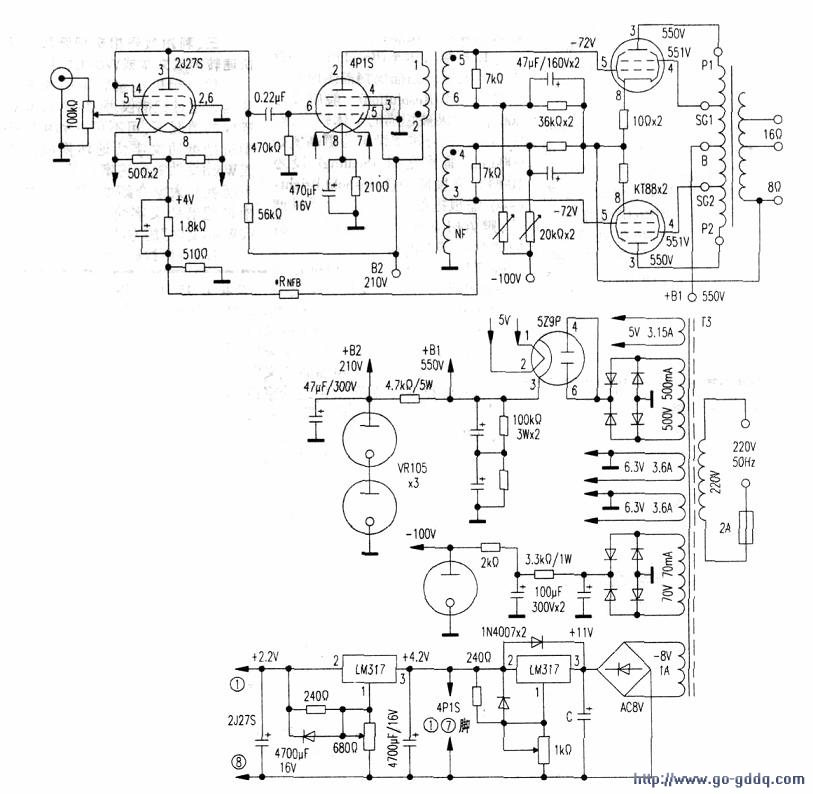Over the past few years, the KT88 has gained immense popularity due to its impressive output power. However, many users find that while the sound is loud, it lacks a certain depth or richness. This suggests that the sound pressure frequency response may not be well balanced, with the midrange frequencies appearing overly dominant compared to the highs and lows. Additionally, the sound's resolution and detail might be lacking. To address these issues, some audiophiles have experimented with direct-heating tube amplifiers, which often yield noticeable improvements. The 4PIS employs an RC-coupled voltage amplification circuit to drive the push-pull output stage. While this approach adds complexity, it also introduces limitations in terms of dynamic range, especially with resistive loads. By adopting a transformer-based load-matching scheme, the 4PIS achieves low distortion and enhanced driving capabilities, allowing for better performance across various impedances.
In this configuration, the 4PIS operates in a Class A/AB1 hybrid mode, offering both dynamic range and low distortion. The design emphasizes obtaining a high-amplitude voltage output, requiring a large load resistor or choke to achieve optimal performance. For instance, in the case of KT88, the recommended load impedance is approximately 4.5kΩ, ensuring a linear working area even under varying conditions. This setup simplifies the winding process for the drive transformer, reducing the number of turns required to maintain low-frequency extension.
The 4PIS power stage is configured to drive two KT88 tubes in an ultralinear configuration, delivering up to 50W per channel. The operating parameters include a plate-to-G2 voltage of 550V, a static current of 2×50mA, and a gate negative voltage of -72V. The total plate dissipation is 27.5W per tube, with a load impedance of 4.5kΩ. Feedback mechanisms, such as the 40% tap on the second grid and a -9dB negative feedback loop, contribute to reducing distortion to around 2% at full power.
For the driver stage, the 4PIS operates in a Class A five-pole connection mode, providing a total cathode current of 32+6.5mA and a gate negative voltage of -8V. The output impedance is matched to 3.5kΩ, ensuring efficient signal transfer. The driver stage is responsible for generating a pair of out-of-phase signals, each with an amplitude of 72.5Vrms, derived from a 1.5W input signal. This arrangement allows for precise control over the output stage, minimizing distortion and maximizing efficiency.
The preamp stage utilizes a 2J27S triode in a three-stage RC-coupled configuration, powered by a 210V supply. The open-loop gain is approximately 14 times, complemented by the 4PIS driver stage’s voltage gain of 14 times. This results in a total gain of 196 times, necessitating an input sensitivity of 255mVp-p for the final stage. To optimize performance, a -10dB negative feedback loop is introduced between the preamp and driver stages, balancing the overall gain and improving linearity.
The power supply employs two sets of high-voltage outputs, with the first providing 550V for the output stage. A 529P full-wave vacuum rectifier ensures a gradual startup, protecting the KT88 tubes from initial stress. Additional filtering is achieved through a combination of resistors and capacitors, reducing ripple and stabilizing the voltage. For the preamp stage, a dual-regulator setup using ICLM317 ensures a stable 210V supply, minimizing noise and maintaining consistent performance.
Two custom transformers are critical to the system’s operation. The output transformer T is designed to match the primary impedance of 4200-4500Ω, supporting a rated output of 50W. The input drive transformer T1, however, requires custom winding due to the lack of off-the-shelf solutions. Its design focuses on achieving efficient power transfer while minimizing losses, leveraging a three-slot plastic skeleton and multi-layered winding techniques. The resulting transformer supports both primary and secondary outputs, facilitating the creation of balanced drive signals.
Finally, adjustments are made to fine-tune the amplifier’s performance. The KT88 gate negative voltage is set to -72V, with precise balancing achieved by monitoring the voltage drop across resistors on each cathode. This ensures symmetric operation and optimal performance. Overall, the 4PIS system represents a carefully engineered solution, balancing complexity with practicality to deliver exceptional audio quality.

Frame For Iphone 14,Metal Frame For Iphone X14Promax,Iphone X14Promax Frame With Glue,Original Frame For Iphone X14Promax
Shenzhen Xiangying touch photoelectric co., ltd. , https://www.starstp.com